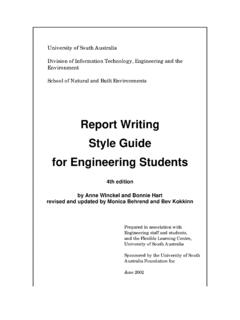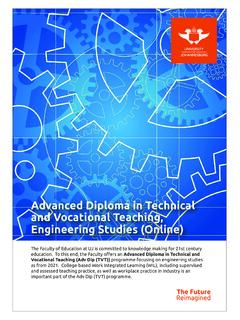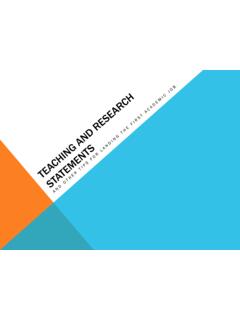Transcription of THE FLIPPED CLASSROOM TEACHING MODEL AND ITS …
1 Volume 8, Issue 1, 2014 THE FLIPPED CLASSROOM TEACHING MODEL AND ITS USE FOR INFORMATION LITERACY INSTRUCTION Sara Arnold-Garza Towson University ABSTRACT The FLIPPED CLASSROOM , a TEACHING method that delivers lecture content to students at home through electronic means and uses class time for practical application activities, may be useful for information literacy instruction. This article describes many of the characteristics of the FLIPPED CLASSROOM TEACHING MODEL , illustrated with examples from current higher education and library instruction literature. Pedagogical benefits of the MODEL are highlighted along with po-tential challenges to its use.
2 7 INVITED COLUMN [PERSPECTIVES] INTRODUCTION The FLIPPED CLASSROOM is known by various names including the inverted CLASSROOM , and more simply, the flip. Origination stories differ, but most credit Jonathan Bergmann and Aaron Sams, high school chemistry teachers from Colorado, who began using recorded lectures in 2006. The flip evolved out of a history of experimentation with the concept of hybrid, or blended learning and problem based learning, using active learning techniques and new technologies to engage students. The FLIPPED CLASSROOM has two defining components: moving the lecture outside of class, usually delivered through some electronic means, and moving the practical application assignments, formerly homework, into the CLASSROOM (Educause, 2012).
3 There are many other optional components that arguably optimize this structure and provide enhanced learning opportunities to students, creating a wide variation in practice ( FLIPPED CLASSROOM offers, 2011). The lecture format has varied and evolved from slides, audio, podcasts, or narrated presentations, to video casts that may also incorporate animations, screen captures, and other multimedia content. The CLASSROOM component is varied as well, with different learning expectations, engagement techniques, levels of student autonomy, and other variability (Sams, 2011).
4 In fact, instructors have taken countless paths to TEACHING with the flip because the learning context and objectives determine which features are most useful (Bull, Fester, & Kjellerstrom, 2012). Khan Academy, Coursera, TED talks, and even YouTube are online resources associated with the FLIPPED CLASSROOM , providing access to recorded lectures, instructional videos, and sometimes other interactive elements for TEACHING and learning. In many cases instructors implementing the flip depend on these resources to provide the lecture content (Bull, Ferster, & Kjellstrom, 2012).
5 Sourcing of content from outside may be helpful for those who lack presentation skills, extensive subject knowledge, or need an outside perspective to enrich their course. Scott McLeod, a leader in educational technology and the Director of Innovation for Prairie Lakes Area Education Agency 8 in Iowa, notes that these large educational video sites are innovations that were not created by established education groups but instead came from outside to fill the vacuum that educators had left (as cited in Tucker, 2012, ), leaving the possibility that as this learning MODEL grows, educators may take back the reigns.
6 WHY USE THE FLIP? Instructors of all kinds cite strengths of the FLIPPED MODEL , including efficient use of class time (Cole, 2009), more active learning opportunities for students (Gannod, Berg & Helmick, 2008), increased one-on-one interaction between student and teacher (Lage, Platt, & Treglia, 2000), student responsibility for learning (Overmyer, 2012), and addressing multiple learning styles ( FLIPPED CLASSROOM offers, 2011; Gallagher, 2009; Gannod, et al., 2008). Each of these features has implications for student learning and may be more strongly or weakly demonstrated depending on the specific implementation.
7 As curriculum requirements grow, instructors are pressured to make more efficient use of class time. In the FLIPPED CLASSROOM , students can get the most out of class time by spending it on practical application, not on inactive lecture (Cole, 2009). Lecture content can be provided just as well through electronic means. Perhaps it can even be improved because professors Arnold-Garza, The FLIPPED CLASSROOM TEACHING MODEL Communications in Information Literacy 8(1), 2014 8 may be obliged to make video lectures a manageable length. This could have the effect of distilling a topic to the most important points with no extraneous information.
8 Or, they may break a topic into several videos addressing subtopics, a technique known as chunking, which could help students access and process a large, interconnected set of ideas more easily. Electronic methods can also take advantage of interactive technologies like online tutorials or quizzes. Sometimes these additional components are employed to reinforce the concepts discussed in the video lecture, other times to ensure that students are actually viewing the lectures before class. This transfer of what has traditionally been passive learning out of the CLASSROOM leaves class time to focus on the more engaging elements of TEACHING and learning.
9 It provides an opportunity to increase meaningful engagement for students without requiring more resources (Schullery, Reck, & Schullery, 2011). The issue of using time differently in this MODEL is associated with many potential improvements: more time to interact and clarify material, more time to explore concepts deeply, and more time for additional learning objectives or practice with active learning (Boucher, Robertson, Wainner & Sanders, 2013). Active learning is not unique to the FLIPPED CLASSROOM MODEL ; instructors have used the strategy of incorporating active learning exercises even before Bonwell and Eison published their report on the technique for the Association for the Study of Higher Education (ASHE) in 1991.
10 Learning by doing is a principle that teachers have used to shape CLASSROOM experiences in many ways. The flip provides more time for active learning to happen in the CLASSROOM setting, and encourages instructors to view incorporation of active learning as a core component of TEACHING , rather than supplemental to a lecture (Gannod, et al., 2008). Increased one-on-one interaction between student and teacher is a by-product of allowing students to engage with concepts, learning materials, and peers in the CLASSROOM . By structuring exercises that allow students to manage themselves in small groups or individually, instructors can address questions and problems as students encounter them and check in with individuals and groups around the CLASSROOM as students work (Lage, et al.)














